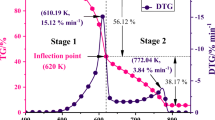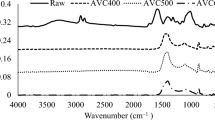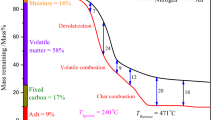Abstract
The challenges of this work focus on better understanding combustion characteristics and their importance to fire hazard by performing thermogravimetric analysis (TGA). The ultimate goal is to provide a methodology for determining the most relevant indices for a robust fire hazard classification of the species. One of the principles of this methodology is the use of a linear regression method for determining the indices and the activation energy. To achieve this scope, chemical, thermal and kinetic analysis will be performed. Nine combustion indices were calculated and compared to assess combustion characteristics such as ignition, combustion and burnout. Experiments were carried out at three heating rates of 10, 15 and 20 °C min−1 under air atmosphere. A selection of forest materials frequently devastated by wildfire, i.e., Quercus pubescens (QP), Quercus suber (QS), Olea europaea (OE) and Genista Salzmannii needles (GSN), were studied. The TG-DTG curves have shown that the combustion process consists of two stages: devolatilization and char oxidation. The whole process was controlled by the release of volatile gases. According to the relative linearized (RL) index of spontaneous ignition, the samples were ordered as follows: OE > GSN ≥ QS > QP. OE appears to be the most reactive and prone to spontaneous ignition compared to the other samples. The same order was achieved for the combustion characteristic index and, approximately, for the integrated flammability. On the other hand, the average Ea at the low temperature stage of the combustion process was low for GSN (147 ± 9 kJ mol−1) and OE (159 ± 4 kJ mol−1) and high for QP (179 ± 14 kJ mol−1) and QS (174 ± 3 kJ mol−1). Finally, this work provides valuable insight into the relationship between chemical properties and combustion indices and the components that make some indices more effective than others.
Graphical abstract









Similar content being viewed by others
Notes
International Plant Name Index.
Abbreviations
- BCI:
-
Burnout characteristic index (% min−4)
- C:
-
Flammability (% min−1 °C−2)
- CCI:
-
Combustion characteristic index (1 min−2 °C−3)
- CSI:
-
Combustion stability index (% min−1 °C−2)
- DIcom :
-
Devolatilization index for combustion (1 min−1 °C−2)
- DDTG:
-
Second derivative mass loss (% min−2)
- DTG:
-
Derivative of thermogravimetry (% min−1)
- DTGmax :
-
Maximum combustion rate (% min−1)
- DTGmean :
-
Mean combustion rate (% min−1)
- DTGshoulder :
-
Combustion rate of shoulder (% min−1)
- DTGpeak :
-
Combustion rate of peak (% min−1)
- Ea :
-
Apparent activation energy (kJ mol−1)
- FC:
-
Fixed carbon (mass%)
- FWO:
-
Flynn–Wall–Ozawa
- GSN:
-
Genista Salzmannii DC. Needles
- HHV:
-
High heating value (MJ kg−1)
- ICI:
-
Ignition characteristic index (% min−3)
- ICTAC:
-
International confederation for thermal analysis and calorimetry
- KAS:
-
Kissinger–Akahira–Sunose
- LHV:
-
Low heating value (MJ kg−1)
- M:
-
Mass loss in each stage
- OE:
-
Olea europaea L.
- QP:
-
Quercus pubescens Willd
- QS:
-
Quercus suber L.
- R:
-
Reactivity (% min−1 °C−1)
- R devolatilization :
-
Reactivity during devolatilization stage (% min−1 °C−1)
- R char oxidation :
-
Reactivity during char oxidation stage (% min−1 °C−1)
- RL indices:
-
Relative linearized indices
- S i :
-
Index of flammability in the stage i
- SII:
-
Spontaneous ignition index
- S n :
-
Integrated flammability
- TGA or TG:
-
Thermogravimetric analysis
- T b :
-
Burnout temperature (°C)
- t b :
-
Corresponding time of Tb (min)
- T DTGmax :
-
Corresponding temperature of DTGmax (°C)
- t DTGmax :
-
Corresponding time of DTGmax (min)
- T pi :
-
Pyrolysis initiation temperature (°C)
- t pi :
-
Pyrolysis initiation time (min)
- T peak :
-
Peak temperature (°C)
- TR:
-
Temperature range
- T shoulder :
-
Shoulder temperature (°C)
- T υ :
-
Initial temperature of volatile release (°C)
- t υ :
-
Corresponding time of Tυ (min)
- VM:
-
Volatile matter (mass%)
- α :
-
Conversion degree
- β :
-
Heating rate (°C min−1)
- \(\Delta T_{1/2}\) :
-
Temperature range at the half value of DTGmax (°C)
- \(\Delta t_{1/2}\) :
-
Time range at the half value of DTGmax (min)
References
Jolly WM, Cochrane MA, Freeborn PH, Holden ZA, Brown TJ, Williamson GJ, Bowman DMJS. Climate-induced variations in global wildfire danger from 1979 to 2013. Nat Commun. 2015;6:1–11.
González Martínez M, Dupont C, da Silva PD, Míguez-Rodríguez L, Grateau M, Thiéry S, Tamminen T, Meyer XM, Gourdon C. Assessing the suitability of recovering shrub biowaste involved in wildland fires in the South of Europe through torrefaction mobile units. J Environ Manage. 2019;236:551–60.
Scott AC, Bowman DM, Bond WJ, Pyne SJ, Alexander ME. Fire on earth: an introduction. New York: Wiley; 2014.
Abbas D, Current D, Ryans M, Taff S, Hoganson H, Brooks KN. Harvesting forest biomass for energy - an alternative to conventional fuel treatments: trials in the Superior National Forest, USA. Biomass Bioenerg. 2011;35:4557–64.
Singh P. Potential of pine needle biomass as an alternative fuel to mitigate forest fire in Uttarakhand Himalayas - a review. J Agric Eng. 2022;58:192–203.
Jones JM, Saddawi A, Dooley B, Mitchell EJS, Werner J, Waldron DJ, Weatherston S, Williams A. Low temperature ignition of biomass. Fuel Process Technol. 2015;134:372–7.
Armakan S, Civan M, Yurdakul S. Determining co-combustion characteristics, kinetics and synergy behaviors of raw and torrefied forms of two distinct types of biomass and their blends with lignite. J Therm Anal Calorim. 2022;147:12855–69.
Meena MK, Anand S, Ojha DK. Interdependency of pyrolysis and combustion: a case study for lignocellulosic biomass. J Therm Anal Calorim. 2023;148:5509–19.
Wnorowska J, Ciukaj S, Kalisz S. Thermogravimetric analysis of solid biofuels with additive under air atmosphere. Energies. 2021;14(8):2257.
Paniagua Bermejo S, Prado-Guerra A, García Pérez AI, Calvo Prieto LF. Study of quinoa plant residues as a way to produce energy through thermogravimetric analysis and indexes estimation. Renew Energy. 2020;146:2224–33.
Liu C, Liu J, Evrendilek F, Xie W, Kuo J, Buyukada M. Bioenergy and emission characterizations of catalytic combustion and pyrolysis of litchi peels via TG-FTIR-MS and Py-GC/MS. Renew Energy. 2020;148:1074–93.
Zhang Y, Kang L, Li H, Huang X, Liu X, Guo L, et al. Characterization of moxa floss combustion by TG/DSC, TG-FTIR and IR. Bioresour Technol. 2019;288.
El-Sayed SA, Ismail MA, Mostafa ME. Thermal decomposition and combustion characteristics of biomass materials using TG/DTG at different high heating rates and sizes in the air. Environ Prog Sustain Energy. 2019;38:1–14.
Wang Q, Wang G, Zhang J, Lee JY, Wang H, Wang C. Combustion behaviors and kinetics analysis of coal, biomass and plastic. Thermochim Acta. 2018;669:140–8.
Song Y, Liu J, Evrendilek F, Kuo J, Buyukada M. Combustion behaviors of Pteris vittata using thermogravimetric, kinetic, emission and optimization analyses. J Clean Prod. 2019;237: 117772.
Liu X, Chen M, Yu D. Oxygen enriched co-combustion characteristics of herbaceous biomass and bituminous coal. Thermochim Acta. 2013;569:17–24.
Zhang Z, Zhang H, Zhou D. Flammability characterisation of grassland species of Songhua Jiang-Nen Jiang Plain (China) using thermal analysis. Fire Saf J. 2011;46:283–8.
Anderson HE. Forest fuel ignitibility. Fire Technol. 1970;6:312–9.
Liodakis S, Kakardakis T. Measuring the particle flammability of forest species from wildland/urban interface (WUI) near athens by thermal analysis. In: 2006 1st international symposium environment identities Mediterranean area, ISEIM. 2006;24–8
Xie T, Wei R, Wang Z, Wang J. Comparative analysis of thermal oxidative decomposition and fire characteristics for different straw powders via thermogravimetry and cone calorimetry. Process Saf Environ Prot. 2020;134:121–30.
Manić N, Janković B, Stojiljković D, Radojević M, Somoza BC, Medić L. Self-ignition potential assessment for different biomass feedstocks based on the dynamic thermal analysis. Clean Eng Technol. 2021;2.
Kumar Mohalik N, Mandal S, Kumar Ray S, Mobin Khan A, Mishra D, Krishna PJ. TGA/DSC study to characterise and classify coal seams conforming to susceptibility towards spontaneous combustion. Int J Min Sci Technol. 2022;32:75–88.
Shu Y, Zhang J, Li W, Zhao P, Zhang Q, Zhou M. Thermogravimetric analysis of the pyrolysis and combustion kinetics of surface dead combustibles in the Daxing’an Mountains. PLoS ONE. 2021;16:1–16.
Liu L, Pang Y, Lv D, Wang K, Wang Y. Thermal and kinetic analyzing of pyrolysis and combustion of self-heating biomass particles. Process Saf Environ Prot. 2021;151:39–50.
García Torrent J, Ramírez-Gómez Á, Fernandez-Anez N, Medic Pejic L, Tascón A. Influence of the composition of solid biomass in the flammability and susceptibility to spontaneous combustion. Fuel. 2016;184:503–11.
Mandal S, Mohalik NK, Ray SK, Khan AM, Mishra D, Pandey JK. A comparative kinetic study between TGA & DSC techniques using model-free and model-based analyses to assess spontaneous combustion propensity of Indian coals. Process Saf Environ Prot. 2022;159:1113–26.
Jia J, Huang R, Wang Y. Study on the combustion characteristics of mountain forest vegetation. Forests. 2022;13.
Fayad J, Morandini F, Accary G, Chatelon FJ, Wandon C, Burglin A, Rossi L, Marcelli T, Cancellieri D, Cancellieri V, Morvan D, Meradji S, Pieri A, Planelles G, Costantini R, Briot P, Rossi JL. A study of two high intensity fires across corsican shrubland. Atmosphere. 2023;14:1–21.
Rahib Y, Leroy-Cancellieri V, Cancellieri D, Quilichini Y. Fire hazard analysis of Mediterranean Genista Salzmannii: pyrolysis and kinetic characterization. J Anal Appl Pyrolysis. 2022;168.
Loo S V and Koppejan J. The handbook of biomass combustion and co-firing. Earthscan 2008. pp. 7–14.
Yang J, Chen H, Zhao W, Zhou J. Combustion kinetics and emission characteristics of peat by using TG-FTIR technique. J Therm Anal Calorim. 2016;124:519–28.
Rahib Y, Leroy-Cancellieri V, Cancellieri D, Awad C, Rossi J-L. Comprehensive characterization of pyrolysis and combustion of genista salzmannii needles (GSN) for fire hazard analysis. In: Advances in forest fire research, Viegas DX, Ribeiro LM, editors. 2022. 1430–36
Sanchez ME, Otero M, Gómez X, Morán A. Thermogravimetric kinetic analysis of the combustion of biowastes. Renew Energy. 2009;34:1622–7.
Rahib Y, Sarh B, Chaoufi J, Bonnamy S, Elorf A. Physicochemical and thermal analysis of argan fruit residues (AFRs) as a new local biomass for bioenergy production. J Therm Anal Calorim. 2021;145:2405–16.
Rahib Y, Elorf A, Sarh B, Bonnamy S, Chaoufi J, Ezahri M. Experimental analysis on thermal characteristics of Argan nut shell (ANS) biomass as a green energy resource. Int J Renew Energy Res. 2019;9:1606–16015.
Reis JS, Araujo RO, Lima VMR, Queiroz LS, da Costa CEF, Pardauil JJR, Chaar JS, Filho GNR, de Souza LKC. Combustion properties of potential Amazon biomass waste for use as fuel. J Therm Anal Calorim. 2019;138:3535–9.
Li J, Hu J, Wang T, Gan J, Xie J, Shui Y, Liu J, Xue Y. Thermogravimetric analysis of the co-combustion of residual petrochemical sludge and municipal sewage sludge. Thermochim Acta. 2019;673:60–7.
Paniagua S, Calvo LF, Escapa C, Coimbra RN, Otero M, García AI. Chlorella sorokiniana thermogravimetric analysis and combustion characteristic indexes estimation. J Therm Anal Calorim. 2018;131:3139–49.
Yi B, Chen M, Gao Y, Cao C, Wei Q, Zhang Z, Li L. Investigation on the co-combustion characteristics of multiple biomass and coal under O2/CO2 condition and the interaction between different biomass. J Environ Manage. 2023;325: 116498.
Huang C, Yu C, Wang G, Zhang J, Ning X, Wang C. Comparison of structural characteristics and combustibility analysis about hydrochar and pyrochar. J Therm Anal Calorim. 2022;147:10509–23.
Yang Y, Lu X, Wang Q. Investigation on the co-combustion of low calorific oil shale and its semi-coke by using thermogravimetric analysis. Energy Convers Manag. 2017;136:99–107.
Vamvuka D, El Chatib N, Sfakiotakis S. Measurements of ignition point and combustion characteristics of biomass fuels and their blends with lignite. Proc Eur Combust Meet. 2011;2015:95.
Ahn S, Choi G, Kim D. The effect of wood biomass blending with pulverized coal on combustion characteristics under oxy-fuel condition. Biomass Bioenerg. 2014;71:144–54.
Vyazovkin S, Burnham AK, Criado JM, Pérez-Maqueda LA, Popescu C, Sbirrazzuoli N. ICTAC kinetics committee recommendations for performing kinetic computations on thermal analysis data. Thermochim Acta. 2011;520:1–19.
Ben Abdallah A, Ben Hassen Trabelsi A, Navarro MV, Veses A, García T, Mihoubi D. Pyrolysis of tea and coffee wastes: effect of physicochemical properties on kinetic and thermodynamic characteristics. J Therm Anal Calorim. 2023;148:2501–15.
Wilk M, Magdziarz A, Gajek M, Zajemska M, Jayaraman K, Gokalp I. Combustion and kinetic parameters estimation of torrefied pine, acacia and Miscanthus giganteus using experimental and modelling techniques. Bioresour Technol. 2017;243:304–14.
Leroy V, Cancellieri D, Leoni E, Rossi JL. Kinetic study of forest fuels by TGA: model-free kinetic approach for the prediction of phenomena. Thermochim Acta. 2010;497:1–6.
Wu KT, Tsai CJ, Chen CS, Chen HW. The characteristics of torrefied microalgae. Appl Energy. 2012;100:52–7.
Du SW, Chen WH, Lucas JA. Pretreatment of biomass by torrefaction and carbonization for coal blend used in pulverized coal injection. Bioresour Technol. 2014;161:333–9.
Mukhopadhyay S, Sarkar P, Masto RE, Singh AK, Singh PK. Investigation on the combustion characteristics of different plant parts of Cassia siamea by DSC-TGA. J Therm Anal Calorim. 2022;147:3469–81.
Deng S, Wang X, Tan H, Mikulčić H, Yang F, Li Z, et al. Thermogravimetric study on the co-combustion characteristics of oily sludge with plant biomass. Thermochim Acta. 2016;633:69–76.
Xu F, Wang B, Yang D, Hao J, Qiao Y, Tian Y. Thermal degradation of typical plastics under high heating rate conditions by TG-FTIR: pyrolysis behaviors and kinetic analysis. Energy Convers Manag. 2018;171:1106–15.
Tian B, Qiao YY, Tian YY, Liu Q. Investigation on the effect of particle size and heating rate on pyrolysis characteristics of a bituminous coal by TG-FTIR. J Anal Appl Pyrolysis. 2016;121:376–86.
Mureddu M, Dessì F, Orsini A, Ferrara F, Pettinau A. Air- and oxygen-blown characterization of coal and biomass by thermogravimetric analysis. Fuel. 2018;212:626–37.
Acknowledgements
This work was funded by the Corsican Collectivity and the French state in the framework of the collaborative project GOLIAT (CPER: 40031).
Author information
Authors and Affiliations
Contributions
YR contributed to conceptualization, methodology, validation, investigation, formal analysis, writing—original draft, writing—review & editing, visualization. VLC contributed to conceptualization, methodology, validation, formal analysis, resources, writing—review & editing, visualization, project administration. DC contributed to conceptualization, methodology, validation, investigation, resources, writing—review & editing, visualization, project administration. JF contributed to investigation, formal analysis, validation. JLR contributed to investigation, formal analysis, validation. EL contributed to investigation, formal analysis, validation.
Corresponding author
Additional information
Publisher's Note
Springer Nature remains neutral with regard to jurisdictional claims in published maps and institutional affiliations.
Supplementary Information
Below is the link to the electronic supplementary material.
Rights and permissions
Springer Nature or its licensor (e.g. a society or other partner) holds exclusive rights to this article under a publishing agreement with the author(s) or other rightsholder(s); author self-archiving of the accepted manuscript version of this article is solely governed by the terms of such publishing agreement and applicable law.
About this article
Cite this article
Rahib, Y., Leroy-Cancellieri, V., Cancellieri, D. et al. Study on the combustion indices of forest species using thermogravimetric analysis. J Therm Anal Calorim 148, 12919–12935 (2023). https://doi.org/10.1007/s10973-023-12557-8
Received:
Accepted:
Published:
Issue Date:
DOI: https://doi.org/10.1007/s10973-023-12557-8




